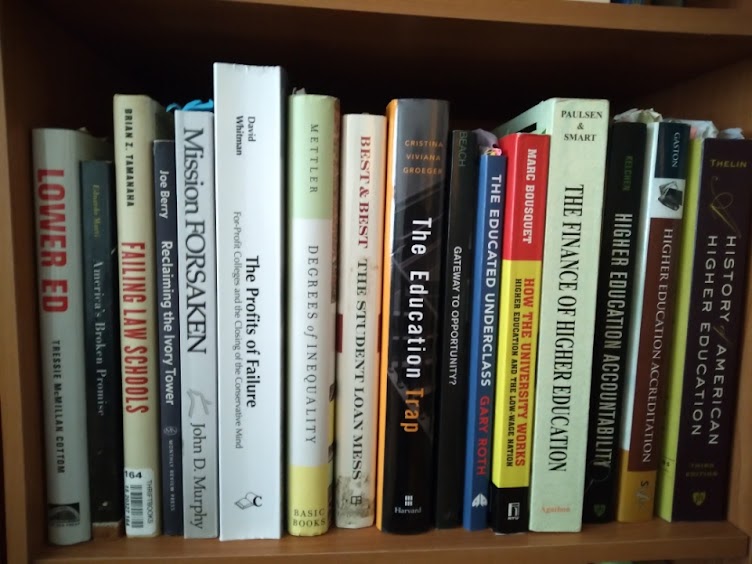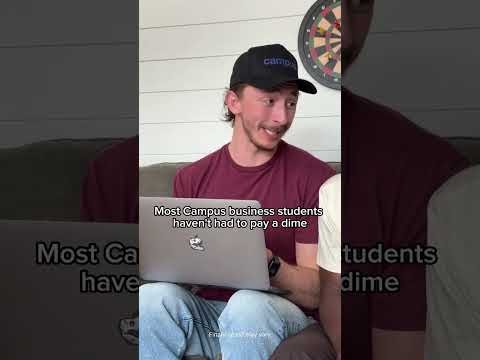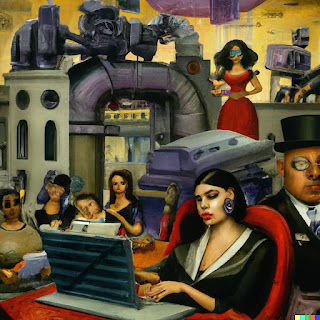[Editor’s Note: Please let us know of any additions or corrections.]
Books
- Alexander, Bryan (2020). Academia Next: The Futures of Higher Education. Johns Hopkins Press.
- Alexander, Bryan (2023). Universities on Fire. Johns Hopkins Press.
- Angulo, A. (2016). Diploma Mills: How For-profit Colleges Stiffed Students, Taxpayers, and the American Dream. Johns Hopkins University Press.
- Apthekar, Bettina (1966) Big Business and the American University. New Outlook Publishers.
- Apthekar, Bettina (1969). Higher education and the student rebellion in the United States, 1960-1969 : a bibliography.
- Archibald, R. and Feldman, D. (2017). The Road Ahead for America’s Colleges & Universities. Oxford University Press.
- Armstrong, E. and Hamilton, L. (2015). Paying for the Party: How College Maintains Inequality. Harvard University Press.
- Arum, R. and Roksa, J. (2011). Academically Adrift: Limited Learning on College Campuses. University of Chicago Press.
- Baldwin, Davarian (2021). In the Shadow of the Ivory Tower: How Universities Are Plundering Our Cities. Bold Type Books.
- Bennett, W. and Wilezol, D. (2013). Is College Worth It?: A Former United States Secretary of Education and a Liberal Arts Graduate Expose the Broken Promise of Higher Education. Thomas Nelson.
- Berg, I. (1970). “The Great Training Robbery: Education and Jobs.” Praeger.
- Berman, Elizabeth P. (2012). Creating the Market University. Princeton University Press.
- Berry, J. (2005). Reclaiming the Ivory Tower: Organizing Adjuncts to Change Higher Education. Monthly Review Press.
- Best, J. and Best, E. (2014) The Student Loan Mess: How Good Intentions Created a Trillion-Dollar Problem. Atkinson Family Foundation.
- Bogue, E. Grady and Aper, Jeffrey. (2000). Exploring the Heritage of American Higher Education: The Evolution of Philosophy and Policy.
- Bok, D. (2003). Universities in the Marketplace : The Commercialization of Higher Education. Princeton University Press.
- Bousquet, M. (2008). How the University Works: Higher Education and the Low Wage Nation. NYU Press.
- Brennan, J & Magness, P. (2019). Cracks in the Ivory Tower. Oxford University Press.
- Brint, S., & Karabel, J. The Diverted Dream: Community colleges and the promise of educational opportunity in America, 1900–1985. Oxford University Press. (1989).
- Cabrera, Nolan L. (2024) Whiteness in the Ivory Tower: Why Don’t We Notice the White Students Sitting Together in the Quad? Teachers College Press.
- Cabrera, Nolan L. (2018). White Guys on Campus: Racism, White Immunity, and the Myth of “Post-Racial” Higher Education. Rutgers University Press.
- Caplan, B. (2018). The Case Against Education: Why the Education System Is a Waste of Time and Money. Princeton University Press.
- Cappelli, P. (2015). Will College Pay Off?: A Guide to the Most Important Financial Decision You’ll Ever Make. Public Affairs.
- Cassuto, Leonard (2015). The Graduate School Mess. Harvard University Press.
- Caterine, Christopher (2020). Leaving Academia. Princeton Press.
- Carney, Cary Michael (1999). Native American Higher Education in the United States. Transaction.
- Childress, H. (2019). The Adjunct Underclass: How America’s Colleges Betrayed Their Faculty, Their Students, and Their Mission University of Chicago Press.
- Cohen, Arthur M. (1998). The Shaping of American Higher Education: Emergence and Growth of the Contemporary System. San Francisco: Jossey-Bass.
- Collins, Randall. (1979/2019) The Credential Society. Academic Press. Columbia University Press.
- Cottom, T. (2016). Lower Ed: How For-profit Colleges Deepen Inequality in America
- Domhoff, G. William (2021). Who Rules America? 8th Edition. Routledge.
- Donoghue, F. (2008). The Last Professors: The Corporate University and the Fate of the Humanities.
- Dorn, Charles. (2017) For the Common Good: A New History of Higher Education in America Cornell University Press.
- Eaton, Charlie. (2022) Bankers in the Ivory Tower: The Troubling Rise of Financiers in US Higher Education. University of Chicago Press.
- Eisenmann, Linda. (2006) Higher Education for Women in Postwar America, 1945–1965. Johns Hopkins U. Press.
- Espenshade, T., Walton Radford, A.(2009). No Longer Separate, Not Yet Equal: Race and Class in Elite College Admission and Campus Life. Princeton University Press.
- Faragher, John Mack and Howe, Florence, ed. (1988). Women and Higher Education in American History. Norton.
- Farber, Jerry (1972). The University of Tomorrowland. Pocket Books.
- Freeman, Richard B. (1976). The Overeducated American. Academic Press.
- Gaston, P. (2014). Higher Education Accreditation. Stylus.
- Ginsberg, B. (2013). The Fall of the Faculty: The Rise of the All Administrative University and Why It Matters
- Gleason, Philip. Contending with Modernity: Catholic Higher Education in the Twentieth Century. Oxford U. Press, 1995.
- Golden, D. (2006). The Price of Admission: How America’s Ruling Class Buys its Way into Elite Colleges — and Who Gets Left Outside the Gates.
- Goldrick-Rab, S. (2016). Paying the Price: College Costs, Financial Aid, and the Betrayal of the American Dream.
- Graeber, David (2018) Bullshit Jobs: A Theory. Simon and Schuster.
- Hamilton, Laura T. and Kelly Nielson (2021) Broke: The Racial Consequences of Underfunding Public Universities
- Johnson, B. et al. (2003). Steal This University: The Rise of the Corporate University and the Academic Labor Movement
- Keats, John (1965) The Sheepskin Psychosis. Lippincott.
- Kelchen, R. (2018). Higher Education Accountability. Johns Hopkins University Press.
- Kezar, A., DePaola, T, and Scott, D. The Gig Academy: Mapping Labor in the Neoliberal University. Johns Hopkins Press.
- Kinser, K. (2006). From Main Street to Wall Street: The Transformation of For-profit Higher Education
- Kozol, Jonathan (2006). The Shame of the Nation: The Restoration of Apartheid Schooling in America. Crown.
- Kozol, Jonathan (1992). Savage Inequalities: Children in America’s Schools. Harper Perennial.
- Labaree, David F. (2017). A Perfect Mess: The Unlikely Ascendancy of American Higher Education. Chicago: University of Chicago Press.
- Labaree, David (1997) How to Succeed in School without Really Learning: The Credentials Race in American Education, Yale University Press.
- Lafer, Gordon (2004). The Job Training Charade. Cornell University Press.
- Loehen, James (1995). Lies My Teacher Told Me. The New Press.
- Lohse, Andrew (2014). Confessions of an Ivy League Frat Boy: A Memoir. Thomas Dunne Books.
- Lucas, C.J. American higher education: A history. (1994).
- Lukianoff, Greg and Jonathan Haidt (2018). The Coddling of the American Mind: How Good Intentions and Bad Ideas Are Setting Up a Generation for Failure. Penguin Press.
- Maire, Quentin (2021). Credential Market. Springer.
- Mandery, Evan (2022) . Poison Ivy: How Elite Colleges Divide Us. New Press.
- Marti, Eduardo (2016). America’s Broken Promise: Bridging the Community College Achievement Gap. Excelsior College Press.
- Mettler, Suzanne ‘Degrees of Inequality: How the Politics of Higher Education Sabotaged the American Dream. Basic Books. (2014)
- Newfeld, C. (2011). Unmaking the Public University.
- Newfeld, C. (2016). The Great Mistake: How We Wrecked Public Universities and How We Can Fix Them.
- Paulsen, M. and J.C. Smart (2001). The Finance of Higher Education: Theory, Research, Policy & Practice. Agathon Press.
- Rosen, A.S. (2011). Change.edu. Kaplan Publishing.
- Reynolds, G. (2012). The Higher Education Bubble. Encounter Books.
- Roth, G. (2019) The Educated Underclass: Students and the Promise of Social Mobility. Pluto Press
- Ruben, Julie. The Making of the Modern University: Intellectual Transformation and the Marginalization of Morality. University Of Chicago Press. (1996).
- Rudolph, F. (1991) The American College and University: A History.
- Rushdoony, R. (1972). The Messianic Character of American Education. The Craig Press.
- Selingo, J. (2013). College Unbound: The Future of Higher Education and What It Means for Students.
- Shelton, Jon (2023). The Education Myth: How Human Capital Trumped Social Democracy. Cornell University Press.
- Simpson, Christopher (1999). Universities and Empire: Money and Politics in the Social Sciences During the Cold War. New Press.
- Sinclair, U. (1923). The Goose-Step: A Study of American Education.
- Stein, Sharon (2022). Unsettling the University: Confronting the Colonial Foundations of US Higher Education, Johns Hopkins Press.
- Stevens, Mitchell L. (2009). Creating a Class: College Admissions and the Education of Elites. Harvard University Press.
- Stodghill, R. (2015). Where Everybody Looks Like Me: At the Crossroads of America’s Black Colleges and Culture.
- Tamanaha, B. (2012). Failing Law Schools. The University of Chicago Press.
- Tatum, Beverly (1997). Why Are All the Black Kids Sitting Together in the Cafeteria. Basic Books
- Taylor, Barret J. and Brendan Cantwell (2019). Unequal Higher Education: Wealth, Status and Student Opportunity. Rutgers University Press.
- Thelin, John R. (2019) A History of American Higher Education. Johns Hopkins U. Press.
- Tolley, K. (2018). Professors in the Gig Economy: Unionizing Adjunct Faculty in America. Johns Hopkins University Press.
- Twitchell, James B. (2005). Branded Nation: The Marketing of Megachurch, College Inc., and Museumworld. Simon and Schuster.
- Vedder, R. (2004). Going Broke By Degree: Why College Costs Too Much.
- Veysey Lawrence R. (1965).The emergence of the American university.
- Washburn, J. (2006). University Inc.: The Corporate Corruption of Higher Education
- Washington, Harriet A. (2008). Medical Apartheid: The Dark History of Medical Experimentation on Black Americans from Colonial Times to the Present. Anchor.
- Whitman, David (2021). The Profits of Failure: For-Profit Colleges and the Closing of the Conservative Mind. Cypress House.
- Wilder, C.D. (2013). Ebony and Ivy: Race, Slavery, and the Troubled History of America’s Universities.
- Winks, Robin (1996). Cloak and Gown:Scholars in the Secret War, 1939-1961. Yale University Press.
- Woodson, Carter D. (1933). The Mis-Education of the Negro.
- Zaloom, Caitlin (2019). Indebted: How Families Make College Work at Any Cost. Princeton University Press.
- Zemsky, Robert, Susan Shaman, and Susan Campbell Baldridge (2020). The College Stress Test:Tracking Institutional Futures across a Crowded Market. Johns Hopkins University Press.
Bledstein, Burton J. (1976). The Culture of Professionalism: The Middle Class and the Development of Higher Education in America. Norton.
Groeger, Cristina Viviana (2021). The Education Trap: Schools and the Remaking of Inequality in Boston. Harvard Press.
Hampel, Robert L. (2017). Fast and Curious: A History of Shortcuts in American Education. Rowman & Littlefield.
Activists, Coalitions, Innovators, and Alternative Voices
College Choice and Career Planning Tools
Innovation and Reform
Higher Education Policy
Data Sources
Trade publications





